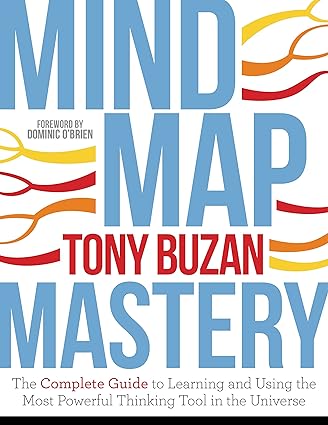In today's information-saturated world, effective thinking, planning, and communication are paramount. Mind mapping, a powerful visual thinking tool, offers a dynamic and intuitive way to organize thoughts, generate ideas, and enhance learning. This white paper explores the principles, benefits, and practical applications of mind mapping, providing a comprehensive guide to mastering this valuable technique.
A Comprehensive Guide to Unleashing the Power of Visual Thinking
Introduction:
In today's information-saturated world, effective thinking, planning, and communication are paramount. Mind mapping, a powerful visual thinking tool, offers a dynamic and intuitive way to organize thoughts, generate ideas, and enhance learning. This white paper explores the principles, benefits, and practical applications of mind mapping, providing a comprehensive guide to mastering this valuable technique.
What is Mind Mapping?
Mind mapping is a visual representation of thoughts, ideas, and concepts, radiating outward from a central keyword or image. Unlike linear note-taking, mind maps utilize a non-linear, radial structure that mirrors the way the brain naturally processes information. This structure incorporates keywords, images, colors, and connecting lines to create a memorable and engaging visual representation of information.
Key Principles of Mind Mapping:
- Central Image/Idea: Begin with a central image or keyword representing the main topic or focus.
- Branches: Main ideas or themes radiate outward from the central image as branches.
- Keywords: Use concise keywords on each branch to represent key concepts.
- Images and Symbols: Incorporate images, symbols, and visual cues to enhance memory and understanding.
- Colors: Utilize colors to categorize, emphasize, and create visual appeal.
- Connecting Lines: Use lines to connect related ideas and create associations.
Benefits of Mind Mapping:
- Enhanced Creativity: The non-linear structure of mind maps encourages brainstorming and the generation of new ideas.
- Improved Memory and Recall: Visual and spatial elements enhance memory encoding and retrieval.
- Increased Productivity and Efficiency: Mind maps provide a structured approach to planning and organizing tasks.
- Better Understanding and Comprehension: Visualizing information helps to clarify complex concepts and relationships.
- Effective Communication: Mind maps provide a clear and concise way to communicate ideas to others.
- Improved Note-Taking: Mind maps offer a more engaging and memorable alternative to linear notes.
Applications of Mind Mapping:
Mind mapping can be applied in various contexts, including:
- Brainstorming: Generating ideas for projects, presentations, or problem-solving.
- Note-Taking: Capturing key information from lectures, meetings, or readings.
- Planning and Organizing: Structuring projects, tasks, and schedules.
- Problem-Solving: Analyzing complex problems and identifying potential solutions.
- Learning and Studying: Consolidating information and preparing for exams.
- Presentations: Creating visually engaging and memorable presentations.
- Decision-Making: Evaluating options and making informed choices.
Creating a Mind Map: A Step-by-Step Guide:
- Start with a Central Image: Place a central image or keyword in the middle of the page or screen.
- Add Main Branches: Draw branches radiating outward from the central image, representing main themes or ideas.
- Use Keywords: Write concise keywords on each branch to represent key concepts.
- Add Sub-Branches: Extend branches with sub-branches to explore related ideas in more detail.
- Incorporate Images and Symbols: Use images, symbols, and visual cues to enhance memory and understanding.
- Use Colors: Apply colors to categorize, emphasize, and create visual appeal.
- Connect Related Ideas: Use lines to connect related ideas and create associations.
Tools for Mind Mapping:
Various tools are available for creating mind maps, including:
- Paper and Pen: The traditional method, offering flexibility and creativity.
- Mind Mapping Software: Digital tools like XMind, MindManager, FreeMind, and Coggle offer advanced features such as branching, image insertion, and collaboration.
Tips for Effective Mind Mapping:
- Use Single Words or Short Phrases: Keep keywords concise for maximum impact.
- Use Images and Symbols: Visual elements significantly enhance memory and understanding.
- Use Colors: Colors add visual appeal and help to categorize information.
- Keep the Layout Organized: Maintain a clear and structured layout for easy navigation.
- Use Cross-Links: Connect related ideas across different branches to create associations.
- Review and Revise: Regularly review and revise your mind maps to reinforce learning.
Mind Mapping and Cognitive Science:
The effectiveness of mind mapping is supported by cognitive science principles, including:
- Dual Coding Theory: This theory suggests that combining verbal and visual information enhances memory and learning. (Reference: Paivio, A. (1986). Mental representations: A dual coding approach. Oxford University Press.)
- Spreading Activation: This model describes how activating one concept in memory can trigger the activation of related concepts. (Reference: Collins, A. M., & Loftus, E. F. (1975). A spreading-activation theory of semantic processing. Psychological review, 82(6), 407.)
- Spatial Cognition: Mind mapping utilizes spatial organization, which is a fundamental aspect of human cognition.
Conclusion:
Mind mapping is a powerful and versatile tool that can significantly enhance thinking, learning, and communication. By understanding its principles and applying it effectively, individuals can unlock their creative potential, improve their memory, and achieve greater success in various areas of life. From brainstorming and note-taking to planning and problem-solving, mind mapping offers a dynamic and intuitive approach to organizing information and unleashing the power of visual thinking.
Further Reading and References:
- Buzan, T. (2006). The Mind Map Book: How to Use Radiant Thinking to Maximize Your Brain's Untapped Potential. Plume.
- Buzan, T., & Buzan, B. (2010). The Mind Map Handbook: The Ultimate Thinking Tool. Thorsons.
- Paivio, A. (1986). Mental representations: A dual coding approach. Oxford University Press.
- Collins, A. M., & Loftus, E. F. (1975). A spreading-activation theory of semantic processing. Psychological review, 82(6),1 407.
This white paper provides a comprehensive overview of mind mapping. Continued practice and exploration of different applications are essential for maximizing the benefits of this powerful technique.
